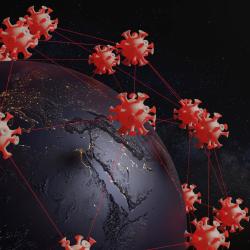From Aardvarks to Zebras—and Everything In-Between
How David Powell’s (Ph.D. ’00, zoology) fascination with animals big and small inspired his career as a leader in zoo biology and animal welfare.
Whether it’s lions or tigers, aardvarks or zebras, David Powell (Ph.D. ’00, zoology) has felt a special connection with animals for as long as he can remember. When he was a toddler, frequent visits to the zoo in his hometown of Atlanta made a lasting impression.
“I have vivid memories even now—they had a giant carousel with all kinds of wild animals on it and I had to ride every single one, and that was spread across multiple visits,” Powell recalled. “I have a picture on my wall of me in the petting zoo with my mom helping me to pet a goat when I was a child in a stroller. So, yeah, I think I just connected with animals really early on.”

Powell’s fascination with animals big and small inspired a successful career as a leader in zoo biology and animal welfare. From the Smithsonian’s National Zoo and Conservation Biology Institute in Washington, D.C. to the Wildlife Conservation Society’s Bronx Zoo in New York City to his current role as director of research at the Saint Louis Zoo, Powell has studied animals from around the world, authoring dozens of studies on animal behavior and conservation.
“For the past 20 years, I’ve really been focusing a lot on animal welfare, animal well-being in zoos, trying to understand how the way we care for animals impacts animal well-being and conservation,” he said. “No matter what I’m doing, I’ve never wanted to be far from animals.”
Growing up with animals
Whether it was visits to Zoo Atlanta, outdoorsy family vacations or nature-oriented excursions with his parents, experiencing the world of animals was always a part of growing up for Powell. At 15, he landed his first summer job at Zoo Atlanta, a job so fun he never wanted to leave.
“I started off on the visitor side, I sold tickets, I did guest relations, I ran the switchboard, I sorted mail. Then, the summer after my freshman year in college, I convinced the mammal curator to let me do a free internship in animal care,” Powell explained. “I came back and worked in the diet kitchen making animal foods and meals. And then the third summer I filled in in the children’s zoo and bird department for a keeper who was out with an injury.”
By the time Powell graduated from the University of Miami with a biology degree, he was more interested than ever in studying animal behavior—and mammals in particular. In 1993, he began his Ph.D. at the University of Maryland, drawn by the university’s strong research connections with the National Zoo.
“Maryland had several adjunct faculty members based around the Smithsonian and at the National Zoo, including Devra Kleiman who was the head of research at the National Zoo and was a world-renowned animal behaviorist and conservation biologist,” Powell explained. “For me, it was the connection to the Smithsonian and the National Zoo in particular that made Maryland my number one choice. I felt like this was really setting me up for a future career.”
With inspiration from Kleiman, Powell studied animal behavior and reproductive biology, focusing on the wild horse population at the Assateague Island National Seashore. After he earned his doctorate, Kleiman recruited him for a very different research project—studying giant pandas in China for the National Zoo.
Horses, pandas and an anxious aardvark
“That was when the National Zoo was putting together their application to bring in giant pandas,” Powell explained. “I was initially hired as a postdoc to study giant pandas at the breeding centers in China to understand why they were struggling to reproduce, and I stayed on at the National Zoo as a researcher and scientist for four years.”
Powell’s next stop was the Bronx Zoo, where he landed a curatorial internship in mammalogy in 2004 and officially got the job two years later.
“At the end of the internship they hired me to be the curator in the mammal department at the Bronx Zoo, so I oversaw all the carnivores and hoofed animals from elephants to tigers lions, rhinos, giraffes, things like that,” Powell explained. “I was still doing some research throughout that period but mainly I was an animal manager and people manager in the largest mammal department in the U.S. at the time.”
For Powell, being a curator meant some unexpected assignments—like assisting a zoo in Alaska with trying to repackage a wolverine that chewed through its crate at an airport or babysitting an anxious aardvark through her first experience with parenthood.
“Aardvarks like it hot, so we had a den box for them, and we heated it to 88 to 90 degrees, and that first night I spent probably an hour in that hot den box with the female helping her baby nurse and hoping she didn’t freak out,” he recalled. “That was strange and very cool.”
Powell’s adventures as zoo curator turned out to be everything he hoped for—and more.
“What I always loved about my job is that I did 90 different kinds of things a day—there were days I’d be at my desk all day, and there were other days when I changed into a uniform and was catching gazelles by hand or doing health exams on a bunch of snow leopards or something like that,” he said.
And when Powell wasn’t working with animals, he was vacationing with them.
“Honestly, I made all my vacations about animals, and I still do that. I’m all about going to crazy parts of the world to see animals,” he said. “Whenever I’ve gone to a new city anywhere in the world, I’ve gone to their zoo, I just really enjoy that.”
‘If I want to go feed a rhino…I can still make time to do that’
In 2016, Powell left New York to join the Saint Louis Zoo as director of research, leading scientific studies on behavior and animal reproduction for the benefit of zoos around the country.
“I think every project we’re working on here is cool, and those projects either relate to supporting animal well-being here at St. Louis or supporting population sustainability, so I can switch to multiple different projects during the day and it keeps it interesting,” he explained. “I’m guiding this team of scientists who are doing super-cool stuff that’s important to animals and important to people. And, if I want to go feed a rhino every now and then, I can still make time to do that.”
For Powell, it’s all part of a bigger commitment to supporting zoos and the work they do now and for generations to come.
“I believe firmly in the role of zoos in society, whether it’s an educational role, a conservation role, a place for people to come and enjoy time with their friends and families, or a science role,” Powell said. “You could say most of my research has been to support the zoological mission—to maintain zoos as leaders in education, research and conservation and enjoyment for the next hundred years.”
Written by Leslie Miller





